Continuous 3D Printing: What Are the Solutions on the Market?
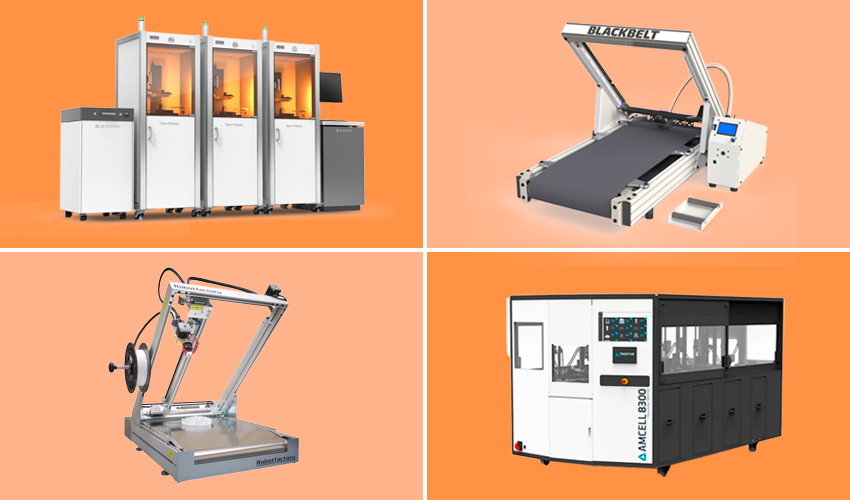
In additive manufacturing and the industrial world at large, automation and continuous production are becoming increasingly important. Numerous companies are developing approaches and solutions to automate their workflows and work with powerful printers that can print continuously for shift operations. One of the main ideas in this context is the integration of an assembly line as a printing platform to produce pieces of great length or smaller parts in series production. In addition, there are other solutions to ensure continuous 3D printing. Automated manufacturing systems, where printing and post-processing take place, enable manufacturing without having to interrupt the process. The list below gives you an insight into which technologies and systems can currently be found on the market and enable continuous 3D printing. Follow along as we list them in alphabetical order of manufacturer.
3D Systems – DP Polar
A previous entrant on our list of continuous 3D printers, the German startup DP Polar has since been acquired by 3D Systems in fall 2022. The company’s designs have not been wasted, however, as the latest printer to bear their name and technology is still in the early access stages. Under the 3D Systems mantle, it seems that DP Polar’s remarkable High-Speed Rotative AM (HSR AM) technology has undergone further development. The main premise is a high-speed, continually rotating build platform with separable, interchangeable segments to allow for constant output. In addition, integrated technologies allow for seamless interaction with ERP systems for greater quality assurance. In addition, pre- and post-processing elements are automated within the system. From the material acquisition, orientation, slicing and part removal, the DP Polar is designed to run with minimal human interaction needed. With an inkjet-based 3D printing system, the build speed allows for a true mass production of complex or specialized parts made of a variety of materials and colors. Further information including steps for early access requests are available from 3D System’s website.
3D Systems – Figure 4
The Figure 4 from industry giant 3D Systems is more of a production platform than a 3D printer. It is a modular solution that allows the combination of several machines or “configurable units” as explained by the manufacturer, both 3D printers or post-processing solutions. From a dedicated control cell, the user can combine up to 16 resin printers creating a semi-automated system and increasing the volume of parts created. Designed wit modularization in mind, the concept allows for greater customization and affordability by the user, who is able to scale up their printer volume as needed with additional printer modules. The printers are able to utilize a wide range of resin materials including thermoplastic- and rubber-like materials, and even biocompatible material.
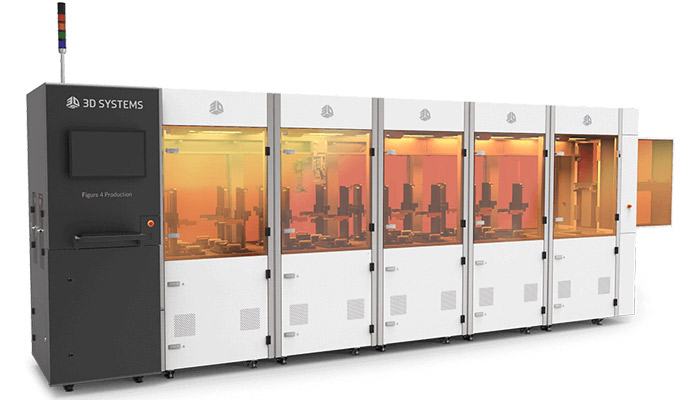
Photo credits: 3D Systems
BlackBelt3D – BlackBelt
The project behind the Blackbelt 3D printer started as a crowdfunding campaign that reached big numbers in a short time. The BlackBelt3D team was not the first to come up with the idea of integrating a conveyor belt, although they were the first to implement it. The BlackBelt is capable of printing under various angles, long parts, unsupported and serial. In terms of technical details, this 3D printer has a maximum print height of 340mm, a maximum print width of 340mm and an infinite print length. The 3D printer can be purchased as a Standalone version that allows printing at ergonomic height (including a controller and support construction) or the Roller Table version that allows printing long parts without limits (with an integrated roller table to hold long parts). Blackbelt works with rigid materials, although it is possible to incorporate an extension that allows printing flexible materials.
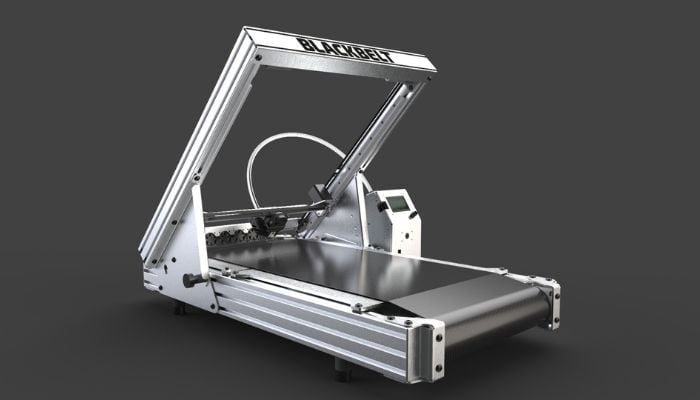
Photo credits: BlackBelt3D
Cosmyx – MIRA
The French manufacturer Cosmyx has brought to life the MIRA solution: a true, connected microfactory dedicated to industrial additive manufacturing. It is a system of FDM 3D printers controlled by a fully automated robot. MIRA is equipped with sensors to monitor the quality and humidity of the production and material storage areas in real time. The robot ensures the automation of inspection of 3D printed parts, their preparation for assembly and packaging. The solution provides round-the-clock production by enabling optimization of repetitive industrial processes and speeding up production without the need for human intervention.
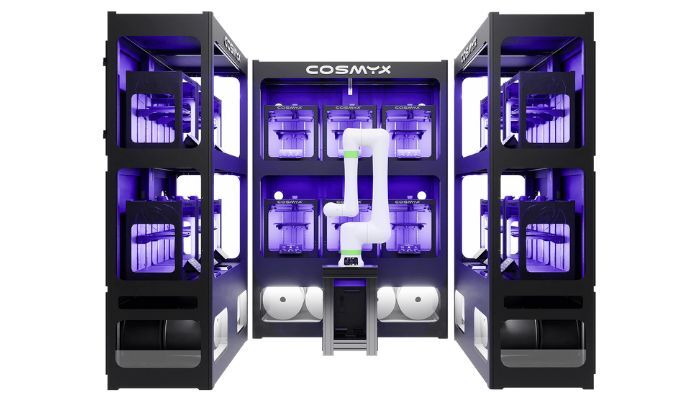
Photo credits: Cosmyx
Creality – 3DPrintMill
The Shenzhen-based manufacturer Creality launched a Kickstarter campaign for this 3D printer project some time ago, and has since continued production. The so-called 3DPrintMill is a machine that integrates a conveyor belt made of nylon and allows the manufacture of pieces with an infinite length; the longest print to date measures 6 meters. The 3DPrintMill is also capable of resuming the printing process in case of power failure, and also allows end-of-filament detection. Its maximum printing volume is 200 x 170 x ∞ mm, slightly less than the BlackBelt mentioned above. This 3D printer is also ideal for mass production without the need for supervision, since as the plate advances, the pieces automatically fall into a container.
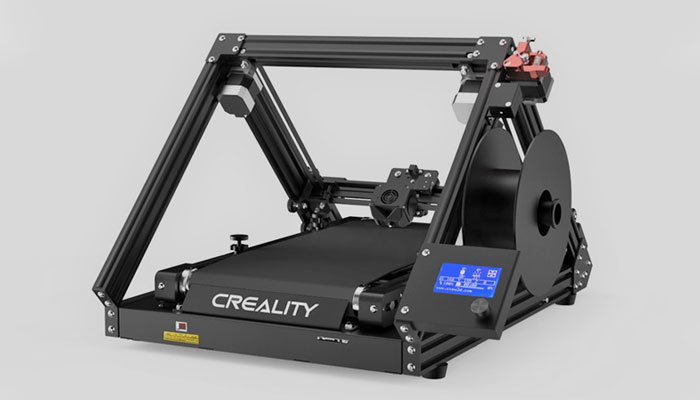
Photo credits: Creality
Formlabs – Form Auto
The Form Auto solution developed by Formlabs is not a 3D printer in the strict sense of the word: it’s an extension that automates the printing process by automatically removing parts from the tray and starting the next print. Form Auto is compatible with Form 3 and Form 3+ machines. It collects parts in a UV-resistant tray, which can then be sent to the Form Wash to begin post-processing. This solution avoids lengthy downtimes for 3D printers, offering a continuous production flow and greater freedom for the operator.
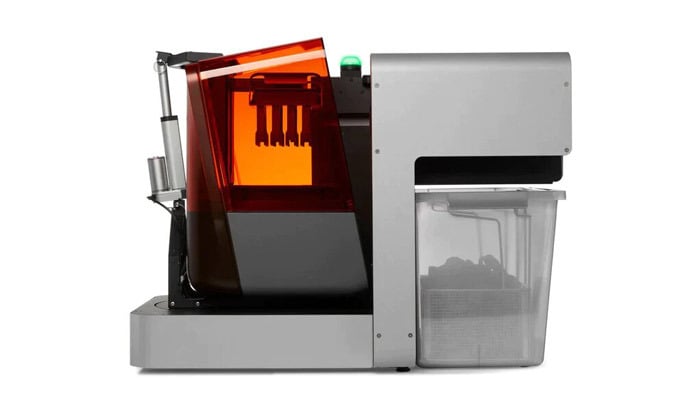
Photo credits: Formlabs
iFactory – iFactory One
The German startup iFactory is a manufacturer of desktop 3D printers based on FDM technology, which developed a conveyer belt 3D printer in 2020. Called iFactory One, this machine allows to 3D print parts of any length and to produce in high-volume without any interruption. This is one of the few 3D printers on the market that features the conveyer belt build plate. This feature is key in allowing continuous production. In fact, its build volume can be said to be 180 mm x 290 mm x infinity (in length). Additionally, the 0.4 mm exchangeable nozzle can reach a temperature of 260 degrees and print at a speed of 200 mm/s. Compatible filaments include PLA, PETG, PC, TPU, NYLON or ABS.
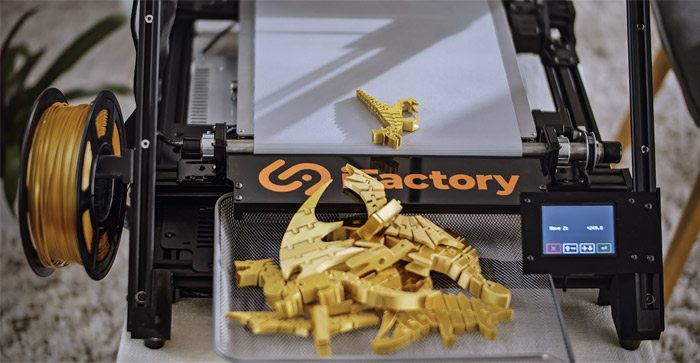
Photo credits: iFactory
HP – HP Jet Fusion 4200
The HP Jet Fusion 4200 is an industrial 3D printer ideal for functional prototyping and small series production. Depending on the application, you can choose a printing mode that prioritizes the part’s mechanical, functional or aesthetic properties, precision or speed. The HP Jet Fusion 4200 features an integrated quality control system, the results of which are displayed on the printer’s touch screen. Its connectivity enables remote control. The printer also features a layer-by-layer thermal control system, enabling predictive voxel-by-voxel corrections. The machine also features an unpacking and material collection system, as well as systems that automatically mix and load materials. There’s also a rapid cooling module. Two HP Jet Fusion 3D manufacturing units are required for continuous 3D printing. The unit just in use is automatically evacuated for cooling as soon as printing is complete.
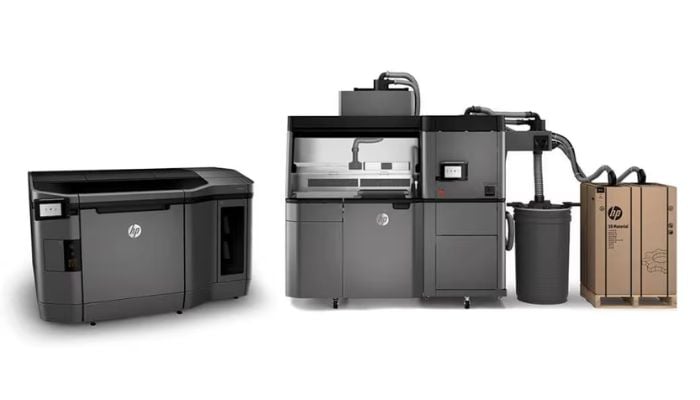
Photo credits: HP
Mosaic Manufacturing – Array
From Toronto-based 3D printing manufacturer Mosaic, the Array prides itself on three pillars of functionality: high throughput, low cost and minimal downtime. The cabinet features four Element / HT 3D printers capable of supporting eight materials per printer, or 32 in total including high-performance polymers such as PEEK or PEKK. Alongside a storage cart for the placement of finished prints, the automation process is equipped to continuously print up to 40 separate print beds. A robotic arm working behind the scenes is able to automatically replace print beds, shuttle finished products to the storage cart and even replace materials. The overall level of automation afforded by the robotic setup is claimed by the manufacturer to increase one’s throughput tenfold and reduce cost per parts drop by up to 95%, depending on the material type. Alongside the machine, controlling the workflow and managing various prints can be done with Mosaics management software, Canvas. Lastly, to emphasize their commitment to quality, Mosaic sends specialists to set up and train users up to and including the first mass-scale production on the client side. Prices are available upon request from the manufacturer’s website.
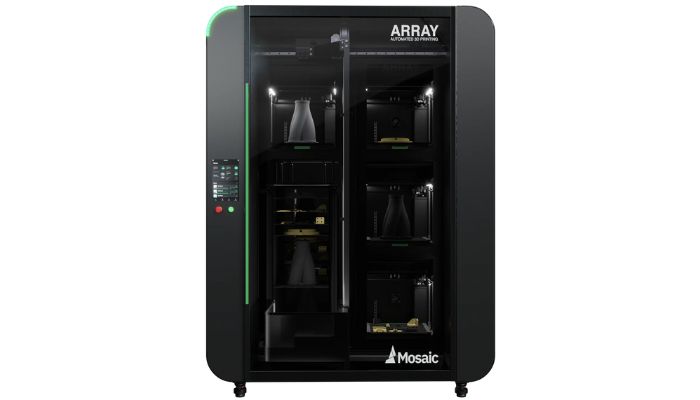
Photo credits: Mosaic
PowerBelt3D – Ender EZ Belt
The Ender EZ Belt is a DIY FDM 3D printer from American manufacturer PowerBelt3D for continuous printing. The Ender EZ Belt project was created to upgrade the Ender-3 printer by making it fully automated with the addition of the sliding print bed. In detail, the Formula32 sliding print bed was created after 28 months of trial and error to create an inexpensive yet durable one. The open-source project is ideal for makers and allows them to obtain the complete 3D printer for $250 to $450, depending on where the components come from.
Prusa – Prusa Pro AFS
Prusa Research was founded as a small one-man company by Josef Průša, a Czech hobbyist, and now one of the most recognized names in the 3D printing industry. The company was founded in 2009 in Prague, Czech Republic, and quickly became one of the leading 3D printing companies. The Prusa Pro AFS has a stand-alone farm system, a next-generation solution for creating rapid prototypes and small batches. It features an easy to use interface and touch screen making it the perfect printer for any level. Some of the advantages of the Prusa Pro AFS over other FDM machines are its ability to start production as you load a file, a wide range of compatible materials and its easy maintenance.
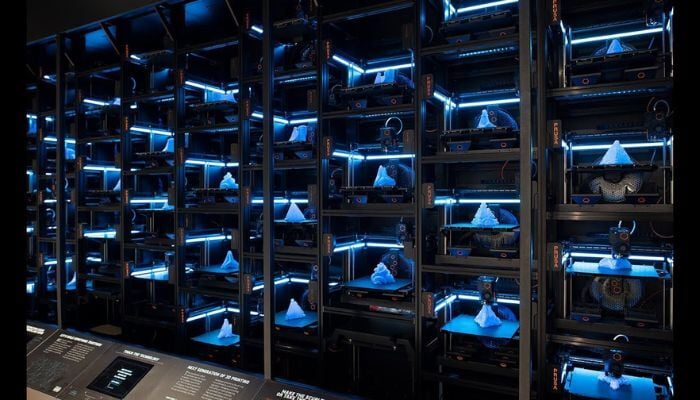
Photo credits: Prusa
RobotFactory – Silver Belt / Sliding-3D
Italian company Robot Factory has been making 3D printers since 2011. One of its flagship models is called Silver Belt: a kit FDM machine with a 45° inclined extruder. This angle enables continuous, support-free printing. As for the 3D printer’s features, it has a printing volume of 270 x 300 mm on the XY axis – so there’s no length limit. According to the manufacturer, assembly of the machine is quick and easy, making it possible to design several serial parts or large objects with ease. Robot Factory also offers the equivalent version already assembled, the Sliding-3D.
Stratasys – Continuous Build
Stratasys is the global leader in 3D printing and additive solutions, materials and services. The company offer a Continuous Build 3D printer with a scalable print capacity which is able to produce parts continuously on a grid of build of build units, without compromising on FDM’s reputation for repeatability and reliability. Stratasys claim their continuous build 3D printer is able to print one to thousands of parts easily and without interruption. The Continuous Build 3D printer is equipped with automatic print prep and setup through SKYLAB Software. The 3D printer is compatible with ABS materials and a build size of 12cm3. Stratasys also developed the J55, a PolyJet 3D printing solution equipped with a rotating platform and stationary printhead. The J55 possesses a unique printing tray which is divided into an active printing area and a transfer zone.
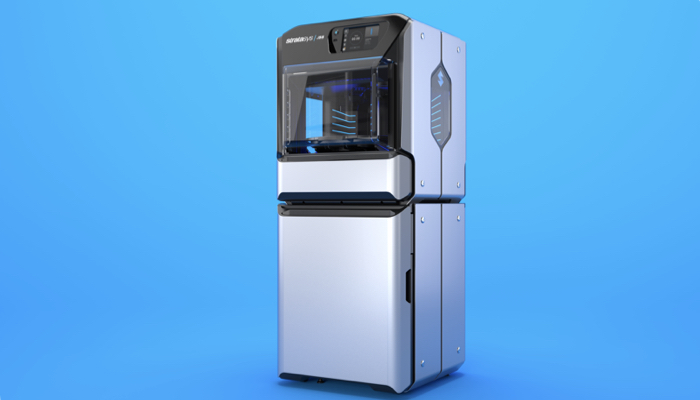
Photo credits: Stratasys
Tiertime – X5
Tiertime is a Chinese company that made a name for itself early on by producing 3D printers and solutions for prototype manufacturing. The X5 is a printer that comes with a total of twelve print beds and is capable of automatically placing up to eight print beds on its build platform and reloading them during the printing process. As a result, the X5 enables continuous 3D printing of small batches. However, the print jobs can also be independent of each other and, for example, commissioned by different people. The X5 then continuously processes these jobs in the queue. At a speed of max. 200 mm/sec, the X5 prints small parts with dimensions of 180 x 230 x 200 mm. The process is based on extrusion, specifically Melted Extrusion Modeling (MEM). For greater safety and the reduction of toxic emissions, the Tiertime X5 is equipped with a dual Hepa and activated carbon filter.
Triditive – AMCELL 8300
The AMCELL 8300 3D printer from Spanish startup Triditive is a robotic cell dedicated to additive manufacturing. It is designed for the mass production of highly complex, precise finished parts. Coupled with EVAM software, it constitutes a real platform dedicated to mass production, enabling manufacturing orders to be managed, processes to be monitored and raw materials to be controlled. Calibration of each print head is automated, as is the ejection of printed parts and their transfer to the manufacturer’s automatic storage module, TRACED. Part traceability is also assured as all these features guarantee the success of continuous 3D printing. The AMCELL 8300, measuring 3.4 x 2 x 2 m, is capable of printing 8 tons of metal per year. It can manufacture parts over an area extending over 300 mm, with a maximum height of 350 mm. With a nozzle diameter range from 0.4 to 0.8 mm, the AMCELL 8300 prints layers with a minimum height of 30 micrometers. It features 8 robots. Its heated enclosure features a temperature control system and filter mechanism and the printing plate can reach 150°C. The 3D printer is compatible with a wide range of polymer materials and composites.
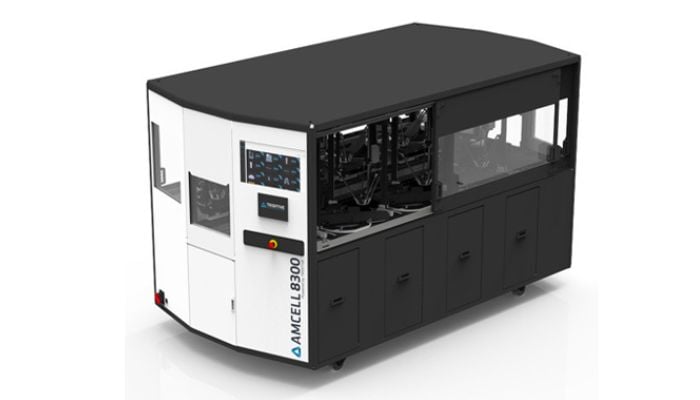
Photo credits: Triditive
Voxeljet – VX1000 HSS
The VX1000 HSS is an industrial polymer printer that can be used as an economical and additive alternative to injection molding. It has been created for continuous use in industrial production and is suitable for mass production in shift operation due to the elimination of unnecessary downtimes during mold changes. It has a 215-liter build volume and uses polymer high-speed sintering to produce components measuring 100 x 540 x 400 mm. Although the VX1000 HSS is designed to process PA12 as standard, other materials can be added to the material portfolio after qualification. The VX1000 HSS is suitable for the production of sophisticated polymer components on an industrial scale, small and medium batch sizes and also for prototyping. Continuous printing is possible due to the automated system.

Photo credits: Voxeljet
What do you think of these continuous 3D printing solutions? Let us know in a comment below or on our LinkedIn, Facebook, and Twitter pages! Don’t forget to sign up for our free weekly Newsletter here, the latest 3D printing news straight to your inbox! You can also find all our videos on our YouTube channel.






